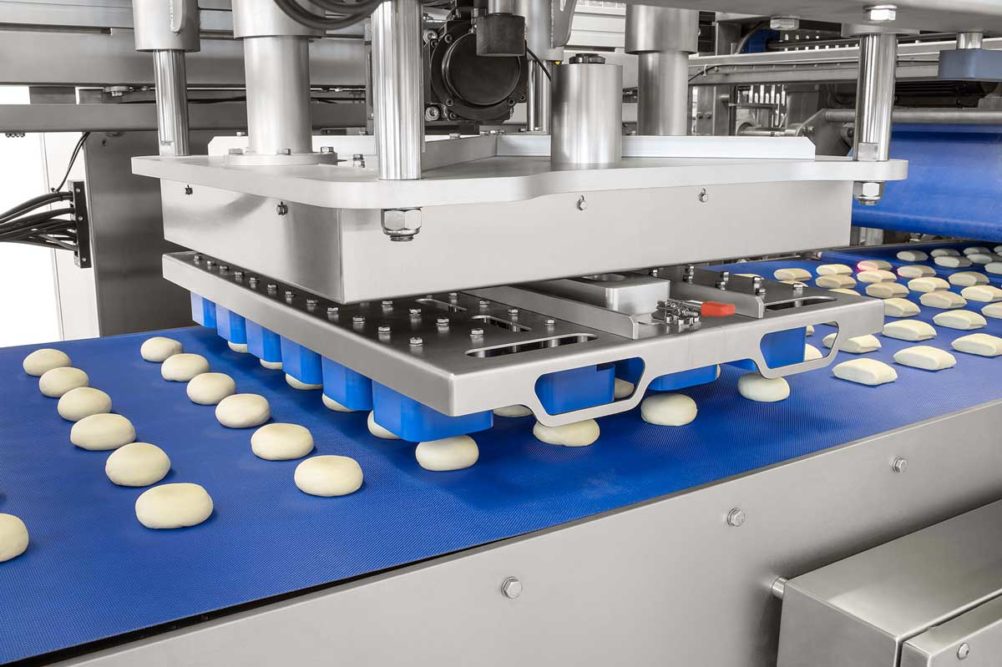As bakers speed up their bun and roll lines, it’s important they don’t overlook how this impacts the moulder or rounder.
“If you just speed up the machine, you have less time to round the product, and this means that the baker must live with a less than perfect mould on high-speed lines,” said Ken Weekes, international sales manager, WP Bakery Group USA.
In response, WP Bakery Group designed its head machine with an expanded moulding drum. This provides the same amount of time to round the dough pieces when the line is sped up. To balance gentle dough processing with high weight accuracy, Mr. Weekes said a servo-driven system and pneumatic positioning devices ensure the dough isn’t overworked and always in position.
“In this way, we can ensure that the line keeps running without the need for operator intervention,” he said.
Fritsch’s BRWI round moulder processes soft, pre-proofed doughs in widths of 900; 1,100; and 1,300 millimeters, enabling bakers to increase capacity without necessarily relying on increasing speed. The machine can create a wide range of products from 30-gram rolls to 1,000-gram loaves, and the moulding tools can be easily exchanged with minimal downtime.
“This is how, for example, 60-gram bread rolls can be produced with eight production rows in a capacity of 17,280 pieces per hour,” said Matt Zielsdorf, director of sales, Fritsch USA, a Multivac company. “Moulding speed and moulding time are adjusted at the operating panel of the rounder/moulder for bread rolls.”
Gemini Bakery Equipment’s TWS RF divider rounder, developed with its equity stockholder W&P Germany, can run a wide range of dough weights at speeds of up to 120 lbs per minute. Its bun and roll systems can produce round, stamp and moulded rolls both in hearth and pan styles.
“We have increased the dough versatility and capacity of the systems on the machine without increasing dough punishment, therefore, the quality is not compromised,” said Mark Rosenberg, CEO, Gemini Bakery Eqiupment.
[Related reading: Patterned buns, rolls differentiate bakers’ offerings]
Selecting the proper equipment empowers bakers to maintain product quality while achieving desired throughput.
“The challenge is not to sacrifice the unique characteristics of a product just to meet production needs,” said John Kirkpatrick, bakery specialist, Reiser. “The equipment should have the versatility to allow for changes in texture, shape, size, density and consistency as the product and market changes. In addition, the equipment must be able to meet the increasing production needs while maintaining product quality as the business grows.”
Reiser’s Vemag bun and roll systems feature positive displacement double-screw technology that can handle a wide range of absorption rates and dough consistencies. With its positive displacement, the Vemag portions dough without overworking it. The double-screw is also available in a variety of configurations and is easily changed out, enabling bakers to make a wide variety of products.
To create the same quality of an artisan bun or roll at industrial levels, Minipan developed its Raffinatore machine. This punch-and-fold sheet generator improves the gluten network of the final product by mimicking traditional methods.
“Thanks to its gentle process, this machine improves the gluten network, homogenizes the air cell distribution in the crumb and gives the loaves an amazing texture,” said Franco Fusari, commercial director and co-owner of Minipan.
This article is an excerpt from the August 2020 issue of Baking & Snack. To read the entire feature on bun and roll tech, click here.






